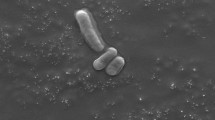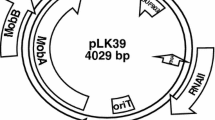Abstract
A 1.6-kb DNA region required for the replication of pSW500 fromErwinia stewartii SW2 has been identified. DNA sequencing analysis revealed that this DNA fragment consists of a DnaA box, seven 16-bp direct repeats, and a 1005-bp open reading frame. The seven direct repeats have been demonstrated to mediate the incompatibility function of the plasmid. Primer extension analysis showed that the 1005-bp ORF is transcribed in vivo and the +1 site of the transcript is located 113 bp upstream from the translation initiation codon of the ORF. Complementation studies showed that this ORF is required for the replication of the plasmid and may encode a replication protein, RepA. Gene fusion studies revealed that the expression ofrepA is autoregulated by RepA. We also found that the pSW500 replicon has a copy number of approximately two and that the plasmid is stably maintained inEscherichia coli, thus demonstrating that the replicon contains all the elements required for copy number control and plasmid stability inE. coli. Curing of pSW500 fromE. stewartii SW2 revealed that loss of pSW500 did not have any obvious effect on morphology or physiology of the cells, suggesting that pSW500 does not encode a function that is indispensable for the survival of the organism.
Similar content being viewed by others
References
Bex F, Pierard P, Desmyter A, Dreze P, Colet M, Couturier M (1986) Mini-F E protein: the carboxy-terminal end is essential for E gene repression and mini-F copy number control. J Mol Biol 189:293–303
Birnboim HC, Doly J (1979) A rapid alkaline extraction procedure for screening recombinant plasmid DNA. Nucleic Acids Res 7:1513–1523
Boyer HW, Roulland-Dussoix D (1969) A complementation analysis of the restriction and modification of DNA inEscherichia coli. J Mol Biol 41:459–472
Brosius J (1984) Plasmid vectors for the selection of promoters. Gene 27:151–160
Chattoraj DK, Cordes K, Abeles A (1984) Plasmid P1 replication: negative control by repeated DNA sequences. Proc Natl Acad Sci USA 81:6456–6460
Chattoraj DK, Snyder KM, Abeles AL (1985) P1 plasmid replication: multiple functions of RepA protein at the origin. Proc Natl Acad Sci 82:2588–2592
Coplin DL, Rowan RG, Chisholm DA, Whitmoyer RE (1981) Characterization of plasmids inErwinia stewartii. Appl Environ Microbiol 42:599–604
Coplin DL, Frederick RD, McCammon SL (1985) Characterization of a conjugative plasmid fromErwinia stewartii. J Gen Microbiol 131:2985–2991
Ditta G, Schmidhauser T, Yakobson E, Lu P, Liang XW, Finlay DR, Guiney D, Helinski DR (1985) Plasmids related to the broad host range vector pRK290 useful for gene cloning and for monitoring gene expression. Plasmid 13:149–153
Filutowicz M, McEachern M, Greener A, Mukhopadhyay P, Uhlenhopp E, Durland R, Helinski D (1985) Role of the π initiation protein and direct nucleotide sequence repeats in the regulation of plasmid R6K replication. In: Helinski DR, Cohen SN, Clewell DB, Jackson DA, Hollaender A (eds) Plasmids in bacteria. Plenum Publishing, New York, pp 125–140
Frederick RD, Coplin DL (1986) Transformation ofEscherichia coli by plasmid DNA fromErwinia stewartii. Mol Plant Pathol 76:1353–1356
Frey J, Chandler M, Caro L (1979) The effects of anE. coli dna Ats mutation on the plasmids ColE1, pSC101, R100.1, and RTF-Tc. Mol Gen Genet 174:117–126
Fu JF, Chang HC, Chen YM, Chang YS, Liu ST (1995) Sequence analysis of anErwinia stewartii plasmid, pSW100. Plasmid 34:75–84
Gay P, Lecoq D, Steinmetz M, Berkelman T, Kado CI (1985) Positive selection procedure for entrapment of insertion sequence element in gram-negative bacteria. J Bacteriol 164:918–921
Gaylo PJ, Turjman N, Bastia D (1987) DnaA protein is required for replication of the minimal replicon of the broad-host-range plasmid RK2 inEscherichia coli. J Bacteriol 168:4703–4709
Grinter NJ (1984) Replication control of IncP plasmids. Plasmid 11:74–81
Guyer MS (1978) The γδ sequence of F is an insertion sequence. J Mol Biol 126:347–365
Hansen EB, Yarmolinsky MB (1986) Host participation in plasmid maintenance: dependence upondnaA of replicons derived from P1 and F. Proc Natl Acad Sci USA 83:4423–4427
Itoh Y, Kamio Y, Terawaki Y (1987) Essential DNA sequence for the replication of Rts1. J Bacteriol 169:1153–1160
Kado CI, Liu ST (1981) Rapid procedure for detection and isolation of large and small plasmids. J Bacteriol 145:1365–1373
Kline BC (1985) A review of mini-F plasmid maintenance. Plasmid 14:1–16
Kues U, Stahl U (1989) Replication of plasmids in gram-negative bacteria. Microbiol Rev 53:491–516
Lin TP, Lai EM, To KY, Chang YS, Liu ST (1994) Transcriptional activation of flanking sequences by Tn1000 insertion. Mol Gen Genet 245:417–423
Linder P, Churchward G, Guixian X, Yi-Yi Y, Caro L (1985) An essential replication gene,repA, of plasmid pSC101 is autoregulated. J Mol Biol 181:383–393
Maniatis T, Fritsch EF, Sambrook J (1982) Molecular cloning: a laboratory manual. Cold Spring Harbor Laboratory Press, Cold Spring Harbor, New York
Miller JH (1972) Experiments in molecular genetics. Cold Spring Harbor Laboratory Press, Cold Spring Harbor, New York
Murotsu T, Matsubara K, Sugisaki H, Takanami M (1981) Nine unique repeating sequences in a region essential for replication and incompatibility of mini-F plasmid. Gene 15:257–271
Oka A, Sugisaki H, Takanami M (1981) Nucleotide sequence of the kanamycin resistance transposon Tn903. J Mol Biol 147:217–226
Pal SK, Mason RJ, Chattoraj DK (1986) P1 plasmid replication: role of initiator titration in copy number control. J Mol Biol 192:275–285
Rokeach LA, Sogaard-Andersen L, Molin S (1985) Two functions of the E protein are key elements in the plasmid F replication control system. J Bacteriol 164:1262–1270
Sanger F, Nicklen S, Coulson AR (1977) DNA sequencing with chain-terminating inhibitors. Proc Natl Acad Sci USA 82:1074–1078
Thomas CM, Smith CA (1987) Incompatibility group P plasmids: genetics, evolution, and use in genetic manipulation. Annu Rev Microbiol 41:77–101
Tolun A, Helinski DR (1981) Direct repeats of the plasmidincC region express F incompatibility. Cell 24:687–694
Trawick JD, Kline BC (1985) A two-stage molecular model for control of mini-F replication. Plasmid 13:59–69
Tsutsui H, Matsubara K (1981) Replication control and switch-off function as observed with a mini-F factor plasmid. J Bacteriol 147:509–516
Tsutsui H, Fujiyama A, Murotsu T, Matsubara K (1983) Role of nine repeating sequences of the mini-F genome for expression of F-specific incompatibility phenotype and copy number control. J Bacteriol 155:337–344
Vocke C, Bastia D (1985) The replication initiator protein of plasmid pSC101 is a transcriptional repressor of its own cistron. Proc Natl Acad Sci USA 82:2252–2256
Yamaguchi K, Masamune Y (1985) Autogenous regulation of synthesis of the replication protein in plasmid pSC101. Mol Gen Genet 200:362–367
Yanisch-Perron C, Vieira J, Messing J (1985) Improved M13 phage cloning vectors and host strains: nucleotide sequences of the M13mp18 and pUC19. Gene 33:103–119
Author information
Authors and Affiliations
Additional information
Communicated by W. Goebel
Rights and permissions
About this article
Cite this article
Fu, JF., Chang, HC., Chen, YM. et al. Characterization of the replicon of plasmid pSW500 ofErwinia stewartii . Molec. Gen. Genet. 250, 699–704 (1996). https://doi.org/10.1007/BF02172981
Received:
Accepted:
Issue Date:
DOI: https://doi.org/10.1007/BF02172981




